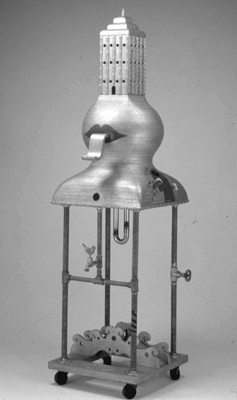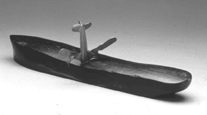
REVIEW
H.C. Westermann
MCA Exhibit
A Journey of Self-discovery
MCA hosts an extensive retrospective exhibition of sculptor H.C. Westermann
By Kris Belden
 Don't call H. C. (Horace Clifford) Westermann a surrealist. Don't call H. C. (Horace Clifford) Westermann a surrealist.
His whimsical-looking sculptures don't articulate any imagined inner fantasies, but are based on real experiences.
Don't call H. C. Westermann a folk artist.
His work is much more complex.
Perhaps the only label you can fairly give H. C. Westermann is "American."
The passion and emotional intensity of his work hints at something characteristically American: A great respect for materials and honest craftsmanship combined with an extraordinary sense of self-context.
The Museum of Contemporary Art celebrates the prolific, prototypically "American" yet underrecognized artist, H. C. Westermann, in an extensive retrospective exhibition running through September 23. Westermann attended the School of the Art Institute of Chicago from 1947-52.
The show is the first comprehensive exhibition of Westermann's work since his death in 1981. The exhibit features 120 of his sculptures, 20 works on paper and his sketchbooks.
Westermann's many well-crafted sculptures are assemblages of materials such as wood, plumbing, nuts and pre-made objects such as toys and bottle caps. They invent a visual language that is profound, impeccably crafted, touching and often humorous. While Westermann's work might appear whimsical at a first glance, at closer inspection it reveals great depth and often conveys a powerful message about the horrors of war, popular culture, and his own self-discovery.
Take Westermann's "Antimobile" for instance. A superbly crafted wooden steering wheel is mounted on a base and it moves, or it would move if it weren't so heavy. The wheel is misshapen and sagging.
Westermann, a veteran of both World War II and the Korean War, created this piece after he returned home to America. It conveys his dismay that items he considered well-crafted "luxury goods" (like cars) were being mass produced, were poorly crafted and were unreliable, but swarms of people still clamoured to buy them anyway. Westermann laments the loss of craft with this big, bulky, misshapen steering wheel that just won't move. Craft, to Westermann, was everything. The great care the former carpenter/stonemason/woodcutter put into his artwork proves that.
His wartime experiences surface in these sculptures too. As a former Marine gunner aboard the U.S.S. Enterprise during World War II, Westermann witnessed kamikaze attacks and other great horrors. He explores the emotions of spending his youth at war in his Death Ship series.
The coffin-like "American Death Ship at the Equator" portrays a stilled ship encased in a glass tomb. The ship calmly sits while a shark waits below for the rusted hulk to sink. As a result of his own war experiences, Westermann was critical of America's involvement in the Vietnam War and the development of the hydrogen bomb. His death ships remind us that where there is war, there is death.
Westermann found another avenue for his post-war self-discovery in his many wooden houses. One of Westermann's house pieces, "Mad House," is very autobiographical. The house bears the artist's Chicago studio address and even has tattoos, just like its creator. The abode appears almost cute at first glance, but upon a closer look, and especially after a gaze inside, the inner thoughts and fears that lurk beneath the former soldier's sturdy, smoothly crafted exterior are revealed by mayhem inside the house. Westermann points out that outside appearances of people can often be deceptive.

Westermann explores these many sides of himself and seems to reconcile that yes he can embody contradictions. But the existence of contradictions makes him human.
But still he's not a surrealist or folk artist.
Don't call Westermann that.
He is pure American.
Other related events:
Prints by H. C. Westermann
Through Sept. 9
David and Alfred Smart Museum of Art
University of Chicago
5550 S. Greenwood Ave.
H. C. Westermann Film Series
MCA features films that shaped Westermann's work or reflect its context.Through Sept. 4
Call 312-397-4010 or see www.mcachicago.org for tickets and information
|

